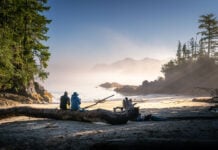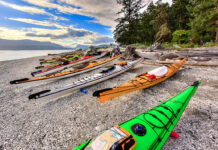Thirty years ago, 11 million gallons of crude oil spilled into one of the world’s best sea kayaking destinations. Images of oil pouring from the torn hull of the Exxon Valdez and spreading across 1,300 miles of Prince William Sound filled the news. Volunteers tried to scrub clean oiled sea otters and birds while Hazmat-suited workers hosed down rocks and steam cleaned beaches.
The oil spill in Exxon Valdez could have been prevented
It was an eminently preventable tragedy. Captain Joe Hazelwood was in his cabin, sleeping off a bender. The third mate missed a turn and plowed the single-hulled tanker into the clearly charted and buoyed Bligh Reef. Alaska Pipeline owners had disbanded their spill response team a few years earlier. The Sound’s remoteness, mostly reachable only by helicopter, plane or boat, slowed response.
On March 24, 1989, I was looking to start a career in environmental work. The following season I went to Alaska as a wet-behind-the-ears Forest Service seasonal. Eight hundred miles away in the panhandle, I tried to explain the spill to visitors gawking at glaciers and vast coastal mountains.
The oil is still there
I recently unrolled my charts for this coming summer’s paddle through the icy fjords and islands of Prince William Sound. The oil is still there, buried under gravel on beaches and hidden in the fatty tissue of orca whales. A 2004 study showed 78 of 91 beaches still had oil on them. Sea otter populations have bounced back, but 17 of 27 other critters, including the herring that feed fishermen, salmon, seabirds and orca, have not.
Our route starts deep in the glacier-filled western fjords, mostly shielded from the plume of oil spread southwest from Bligh Reef. Then we’ll head east and north to the craggy shoreline of Knight Island, firmly in the path of the spill. Herring Bay, our endpoint, is a deep bay with scalloped beaches. Responders tried to shunt the oil into the Bay in a desperate and futile attempt to contain the spread. I wonder what I’ll find when I scoop up the beach gravel.
Why aren’t we talking about it?
Strangely, the spill barely came up in conversation as we planned our trip, until I asked. It makes sense—the Sound, with its glaciers, mountains and islands, is beautiful. Pollution and dams impact my backyard waters too, and I love them anyway. What’s to be done other than to continue to love Prince William Sound? The oil doesn’t go back into the tanker any more than the toothpaste goes back into the tube.
Kayaking has increased in the Sound since the spill. “The settlement funded the Whittier access road [access had been only by train] which has brought more pleasure boat traffic, hunting, fishing, and kayaking to western PWS,” said Paul Twardock, guidebook author, paddler and professor of outdoor studies at Alaska Pacific University. “If you haven’t been there, you’ll probably think it’s an amazing place, which it is, but pre-spill, pre-Whittier road it had very few pleasure boaters.”
Without knowledge of what it was before, I won’t know what wildlife is missing. But the nagging feeling will be there.
“It’s quiet in Prince William Sound,” fisherman Tom Copeland told journalist Doug Struck in 2009. “You don’t see the wildlife that you used to see.”
And there lies the paradox of ecological tragedy. We’re told to move on; to progress through denial, anger and grief to acceptance. But tragedies caused by neglect hold lessons, and acceptance can doom us to repeat history. Oil-filled trains chug down the banks of my local river, the Columbia. For years, my friend had warned about the risk of a spill. In 2016, one jumped the tracks and 11 tank cars caught fire. We dodged a bullet because of luck, not because we learned. Last year the federal government stopped requiring oil trains to use modern electronic brakes.
Marybeth Holleman, who lived in Whittier in 1989, carried a vial of oil around in her purse for six years as she struggled to make sense of the spill. In the end, she wrote, that like loving a person “loving a place unconditionally requires a willingness not just to fight for its protection, but also to change along with it.”
Grant Sims, another writer, likened Prince William Sound to Katherine Hepburn’s beauty—more captivating and distinctive as she aged than the innocent look of youth.
This summer, I’ll find out.
Neil Schulman paddles and writes from Portland, Oregon. After the spill, the Exxon Valdez was repaired and renamed, and continued service as an oil tanker overseas until it was dismantled for scrap in 2012. After 19 years of legal wrangling, the US Supreme Court limited Exxon’s damages to $507 million in a year of $45 billion in profits.
“Despite heroic efforts involving more than 11,000 people, $2 billion, and aggressive application of the most advanced technology available, only about eight percent of the oil was ever recovered,” says Dr. Jeffrey Short, research chemist, Oceana USA. Feature Photo: united states coast guard









